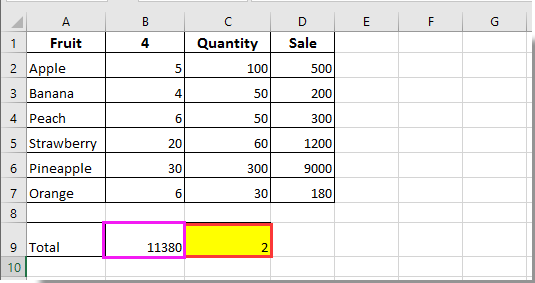How to count the number of times a cell is changed in Excel?
To count the number of times a specified cell is changed in Excel, the VBA codes provided in this article can help.
Count the number of times a cell is changed with VBA code
Count the number of times a cell is changed with VBA code
The following VBA codes can help you to count the number of times a specified cell is changed in Excel.
1. In worksheet that contains one or more cells for which you need to calculate the total change, right-click the sheet tab, and then click View Code from the context menu. See screenshot:

2. In the opening Microsoft Visual Basic for Applications window, copy and paste one of the following VBA codes into the Code window according to your needs.
VBA code 1: Track changes to one cell only
Dim xCount As Integer
Private Sub Worksheet_Change(ByVal Target As Range)
Dim xRg As Range, xCell As Range
On Error Resume Next
If Target = Range("B9") Then
xCount = xCount + 1
Range("C9").Value = xCount
End If
Application.EnableEvents = False
Set xRg = Application.Intersect(Target.Dependents, Me.Range("B9"))
If Not xRg Is Nothing Then
xCount = xCount + 1
Range("C9").Value = xCount
End If
Application.EnableEvents = True
End SubNote: In the code, B9 is the cell you need to count its changes, and C9 is the cell to populate the counting result. Please change them as you need.
VBA code 2: Track changes to multiple cells in a column
Private Sub Worksheet_Change(ByVal Target As Range)
'Updated by Extendoffice 20220916
Dim xSRg As Range
Dim xRRg As Range
Set xSRg = Range("B9:B1000")
Set xCell = Intersect(xSRg, Target)
If xCell Is Nothing Then Exit Sub
Application.EnableEvents = False
On Error Resume Next
Set xCell = xCell.Range("A1")
Set xRRg = xCell.Offset(0, 1)
xRRg.Value = xRRg.Value + 1
Application.EnableEvents = True
End SubNote: In this line "Set xRRg = xCell.Offset(0, 1)", the number 1 represents the number of columns to offset to the right of the starting reference (here the starting reference is column B, and the count you want to return is in column C which locates next to column B). If you need to output the results in column S, change the number 1 to 10.
From now on, when cell B9 or any cell in the range B9:B1000 changes, the total number of changes will be superimposed and automatically filled into the specified cell.


Unlock Excel Magic with Kutools AI
- Smart Execution: Perform cell operations, analyze data, and create charts—all driven by simple commands.
- Custom Formulas: Generate tailored formulas to streamline your workflows.
- VBA Coding: Write and implement VBA code effortlessly.
- Formula Interpretation: Understand complex formulas with ease.
- Text Translation: Break language barriers within your spreadsheets.
Best Office Productivity Tools
Supercharge Your Excel Skills with Kutools for Excel, and Experience Efficiency Like Never Before. Kutools for Excel Offers Over 300 Advanced Features to Boost Productivity and Save Time. Click Here to Get The Feature You Need The Most...
Office Tab Brings Tabbed interface to Office, and Make Your Work Much Easier
- Enable tabbed editing and reading in Word, Excel, PowerPoint, Publisher, Access, Visio and Project.
- Open and create multiple documents in new tabs of the same window, rather than in new windows.
- Increases your productivity by 50%, and reduces hundreds of mouse clicks for you every day!
All Kutools add-ins. One installer
Kutools for Office suite bundles add-ins for Excel, Word, Outlook & PowerPoint plus Office Tab Pro, which is ideal for teams working across Office apps.
- All-in-one suite — Excel, Word, Outlook & PowerPoint add-ins + Office Tab Pro
- One installer, one license — set up in minutes (MSI-ready)
- Works better together — streamlined productivity across Office apps
- 30-day full-featured trial — no registration, no credit card
- Best value — save vs buying individual add-in